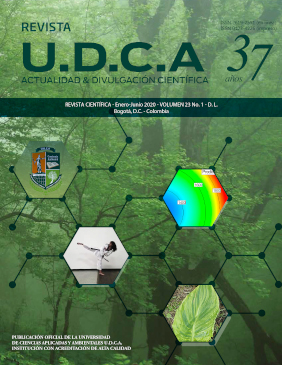Efecto del pH sobre propiedades mecánicas, fisicoquímicas y morfológicas en películas comestibles multicomponentes
Effect of pH on mechanical, physicochemical and morphological properties in multicomponent edible films
Contenido principal del artículo
Resumen
El pH es un parámetro fundamental a considerarse en el momento de diseñar películas multicomponentes, debido a que interviene en la compatibilidad e interacciones que se generan entre los componentes de la matriz, determina la funcionalidad de las mismas y como se demuestra en este estudio, el pH tiene una influencia significativa en las propiedades mecánicas, fisicoquímicas y morfologías de las películas. Con ese objetivo, se sometieron películas a base de goma gellan, gelatina, caseinato de calcio, aceite de canola, glicerol, tween 80 y natamisina, a cuatro niveles de pH T1:6,6 T2:6,2 T3:5,8 T4:5,4 para evaluar y determinar la influencia del pH en las propiedades finales de las películas. Como resultado obtenido en las propiedades, se presentaron diferencias significativas (α=0,05), influenciadas por la modificación del pH, de modo que, en las películas sometidas a un pH de T4=5,4 se generó una mejor compatibilidad de los componentes, por las condiciones del medio que permitieron obtener interacciones por fuerzas electrostáticas entre los polímeros y el aceite, evidenciándose en el mejor comportamiento mecánico con una elongación de 10,6 ± 1,8%, mayor permeabilidad al vapor de agua, solubilidad de 51 ± 0,02% y un contenido de humedad de 9 ± 3,0%; a diferencia de las películas de T1, en las cuales, predominaron las interacciones a través de los enlaces de hidrógeno, afectando la permeabilidad y el comportamiento mecánico de las mismas. En películas multicomponentes a base polímeros y lípidos para garantizar mayor compatibilidad e interacciones que se reflejan en mejores propiedades mecánicas, fisicoquímicas y morfológicas entre los componentes se deben elaborar películas a pH de 5,4 o, en caso contrario, en los cuales, las propiedades deban permitir mayores interacciones entre grupos polares de los componentes utilizar pH más básicos, como pH de 6,6.
Palabras clave:
Descargas
Datos de publicación
Perfil evaluadores/as N/D
Declaraciones de autoría
- Sociedad académica
- Universidad de Ciencias Aplicadas UDCA
- Editorial
- Universidad de Ciencias Aplicadas y Ambientales U.D.C.A
Detalles del artículo
Referencias (VER)
ACOSTA, S.; JIMÉNEZ, A.; CHÁFER, M.; GONZÁLEZ-MARTÍNEZ, C.; CHIRALT, A. 2015. Physical properties and stability of starch-gelatin based films as affected by the addition of esters of fatty acids. Food Hydrocolloids. (Netherlands). 49:135-143. https://doi.org/10.1016/j.foodhyd.2015.03.015
AHMADI, R.; KALBASI-ASHTARI, A.; OROMIEHIE, A.; YARMAND, M.-S.; JAHANDIDEH, F. 2012. Development and characterization of a novel biodegradable edible film obtained from psyllium seed (Plantago ovata Forsk). J. Food Engineering. (Netherlands). 109(4):745-751. https://doi.org/10.1016/j.jfoodeng.2011.11.010
ARRIETA, M.P.; PELTZER, M.A.; GARRIGÓS, M. DEL C.; JIMÉNEZ, A. 2013. Structure and mechanical properties of sodium and calcium caseinate edible active films with carvacrol. J. Food Engineering. 114(4):486-494. https://doi.org/10.1016/j.jfoodeng.2012.09.002
ARRIETA, M.P.; PELTZER, M.A.; LÓPEZ, J.; GARRIGÓS, M. DEL C.; VALENTE, A.J.M.; JIMÉNEZ, A. 2014. Functional properties of sodium and calcium caseinate antimicrobial active films containing carvacrol. J. Food Engineering. 121:94-101. https://doi.org/10.1016/j.jfoodeng.2013.08.015
ASTM INTERNATIONAL. 2002. ASTM D882 - 02. Standard Test Method for Tensile Properties of Thin Plastic Sheeting.
BENAVIDES, S.; VILLALOBOS-CARVAJAL, R.; REYES, J.E. 2012. Physical, mechanical and antibacterial properties of alginate film: Effect of the crosslinking degree and oregano essential oil concentration. J. Food Engineering. 110(2):232-239. https://doi.org/10.1016/j.jfoodeng.2011.05.023
BIERHALZ, A.C.K.; DA SILVA, M.A.; BRAGA, M.E.M.; SOUSA, H.J.C.; KIECKBUSCH, T.G. 2014. Effect of calcium and/or barium crosslinking on the physical and antimicrobial properties of natamycin-loaded alginate films. LWT - Food Science and Technology. (Estados Unidos). 57(2):494-501. https://doi.org/10.1016/j.lwt.2014.02.021
BONILLA, J.; ATARÉS, L.; VARGAS, M.; CHIRALT, A. 2012. Edible films and coatings to prevent the detrimental effect of oxygen on food quality: Possibilities and limitations. J. Food Engineering. 110(2):208-213. https://doi.org/10.1016/j.jfoodeng.2011.05.034
CAO, N.; FU, Y.; HE, J. 2007. Preparation and physical properties of soy protein isolate and gelatin composite films. Food Hydrocolloids. 21(7):1153-1162. https://doi.org/10.1016/j.foodhyd.2006.09.001
CAZÓN, P.; VELAZQUEZ, G.; RAMÍREZ, J.A.; VÁZQUEZ, M. 2017. Polysaccharide-based films and coatings for food packaging: A review. Food Hydrocolloids. 68:136-148. https://doi.org/10.1016/j.foodhyd.2016.09.009
CERQUEIRA, M.A.; SOUZA, B.W.S.; TEIXEIRA, J.A.; VICENTE, A. 2012. Effect of glycerol and corn oil on physicochemical properties of polysaccharide films – A comparative study. Food Hydrocolloids. 27(1):175-184. https://doi.org/10.1016/j.foodhyd.2011.07.007
CHAMBI, H.; GROSSO, C. 2006. Edible films produced with gelatin and casein cross-linked with transglutaminase. Food Research Internal. (Netherlands). 39(4):458-466. https://doi.org/10.1016/j.foodres.2005.09.009
DE KRUIF, C.G.; WEINBRECK, F.; DE VRIES, R. 2004. Complex coacervation of proteins and anionic polysaccharides. Current Opinion in Colloid & Interface Science. 9(5):340-349. https://doi.org/10.1016/j.cocis.2004.09.006
ESTEGHLAL, S.; NIAKOUSARI, M.; HOSSEINI, S.M.H. 2018. Physical and mechanical properties of gelatin-CMC composite films under the influence of electrostatic interactions. Internal J. Biological Macromolecules. (Netherlands). 114:1-9. https://doi.org/10.1016/j.ijbiomac.2018.03.079
GALUS, S.; LENART, A. 2013. Development and characterization of composite edible films based on sodium alginate and pectin. J. Food Engineering. 15(4):459-465. https://doi.org/10.1016/j.jfoodeng.2012.03.006
GARAVAND, F.; ROUHI, M.; RAZAVI, S.H.; CACCIOTTI, I.; MOHAMMADI, R. 2017. Improving the integrity of natural biopolymer films used in food packaging by crosslinking approach: A review. Internal J. Biological Macromolecules. 104:687-707. https://doi.org/10.1016/j.ijbiomac.2017.06.093
GENNADIOS, A.; WELLER, C.L.; GOODING, C.H. 1994. Measurement errors in water vapor permeability of highly permeable, hydrophilic edible films. J. Food Engineering. 21(4):395-409. https://doi.org/10.1016/0260-8774(94)90062-0
GHASEMLOU, M.; KHODAIYAN, F.; OROMIEHIE, A. 2011. Physical, mechanical, barrier, and thermal properties of polyol-plasticized biodegradable edible film made from kefiran. Carbohydrate Polymers. (United Kingdom). 84(1):477-483. https://doi.org/10.1016/j.carbpol.2010.12.010
HAN, J.H.; FLOROS, J.D. 1997. Casting Antimicrobial Packaging Films and Measuring Their Physical Properties and Antimicrobial Activity. J. Plastic Film & Sheeting. (United States). 13(4):287-298. https://doi.org/10.1177/875608799701300405
HASSAN, B.; CHATHA, S.A.S.; HUSSAIN, A.I.; ZIA, K.M.; AKHTAR, N. 2018. Recent advances on polysaccharides, lipids and protein based edible films and coatings: A review. Internal J. Biological Macromolecules. 109:1095-1107. https://doi.org/10.1016/j.ijbiomac.2017.11.097
JIMÉNEZ, A.; FABRA, M.J.; TALENS, P.; CHIRALT, A. 2012. Effect of re-crystallization on tensile, optical and water vapor barrier properties of corn starch films containing fatty acids. Food Hydrocolloids. 26(1):302-310. https://doi.org/10.1016/j.foodhyd.2011.06.009
JRIDI, M.; HAJJI, S.; AYED, H.; LASSOUED, I.; MBAREK, A.; KAMMOUN, M.; SOUISSI, N.; NASRI, M. 2014. Physical, structural, antioxidant and antimicrobial properties of gelatin–chitosan composite edible films. Internal J. Biological Macromolecules. 67:373-379. https://doi.org/10.1016/j.ijbiomac.2014.03.054
KHODAEI, D.; OLTROGGE, K.; HAMIDI-ESFAHANI, Z. 2019. Preparation and characterization of blended edible films manufactured using gelatin, tragacanth gum and, Persian gum. LWT. 117(2020):108617. https://doi.org/10.1016/j.lwt.2019.108617
LEE, K.Y.; SHIM, J.; LEE, H.G. 2004. Mechanical properties of gellan and gelatin composite films. Carbohydrate Polymers. 56(2):251-254. https://doi.org/10.1016/j.carbpol.2003.04.001
MANRICH, A.; MOREIRA, F.K.V.; OTONI, C.G.; LOREVICE, M.V.; MARTINS, M.A.; MATTOSO, L.H.C. 2017. Hydrophobic edible films made up of tomato cutin and pectin. Carbohydrate Polymers. 164:83-91. https://doi.org/10.1016/j.carbpol.2017.01.075
McCLEMENTS, D.J. 2005. Colloidal Interactions. Chapter 3. In: Food Emulsions: Principles, Practices, and Techniques. 3rd Edition. London. CRC Press. p.39-82.
MONEDERO, F.M.; FABRA, M.J.; TALENS, P.; CHIRALT, A. 2010. Effect of calcium and sodium caseinates on physical characteristics of soy protein isolate–lipid films. J. Food Engineering. 97(2):228-234. https://doi.org/10.1016/j.jfoodeng.2009.10.014
PAN, H.; JIANG, B.; CHEN, J.; JIN, Z. 2014. Blend-modification of soy protein/lauric acid edible films using polysaccharides. Food Chemistry. (Netherlands). 151:1-6. https://doi.org/10.1016/j.foodchem.2013.11.075
PEREDA, M.; PONCE, A.G.; MARCOVICH, N.E.; RUSECKAITE, R.A.; MARTUCCI, J.F. 2011. Chitosan-gelatin composites and bi-layer films with potential antimicrobial activity. Food Hydrocolloids. 25(5):1372-1381. https://doi.org/10.1016/j.foodhyd.2011.01.001
QI, G.; LI, N.; SUN, X.S.; SHI, Y.; WANG, D. 2016. Effects of glycerol and nanoclay on physiochemical properties of camelina gum-based films. Carbohydrate Polymers. 152:747-754. https://doi.org/10.1016/j.carbpol.2016.07.068
RHIM, J.W.; SHELLHAMMER, T.H. 2005. Lipid-based edible films and coatings. In: Innovations in Food Packaging. p. 362-383. https://doi.org/10.1016/B978-012311632-1/50053-X
SANYANG, M.L.; SAPUAN, S.M.; JAWAID, M.; ISHAK, M.R.; SAHARI, J. 2016. Effect of plasticizer type and concentration on physical properties of biodegradable films based on sugar palm (Arenga pinnata) starch for food packaging. J. Food Science and Technology. (United Kingdom). 53(1):326-336. https://doi.org/10.1007/s13197-015-2009-7
TONGNUANCHAN, P.; BENJAKUL, S.; PRODPRAN, T. 2013. Physico-chemical properties, morphology and antioxidant activity of film from fish skin gelatin incorporated with root essential oils. J. Food Engineering.117(3):350-360. https://doi.org/10.1016/j.jfoodeng.2013.03.005
YILDIRIM, M.; MAHMUT, S.; SADIKOGL, H. 2019. Development and characterization of edible films based on modified corn starch and grape juice. Food Chemistry. 292:6-13. https://doi.org/10.1016/j.foodchem.2019.04.006







